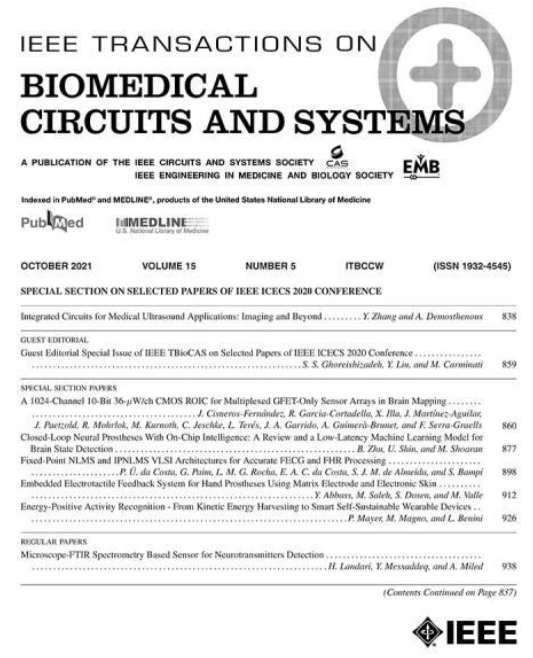A High-Voltage-Tolerant and Precise Charge-Balanced Neuro-Stimulator in Low Voltage CMOS Process
IF 4.9
2区 医学
Q2 ENGINEERING, BIOMEDICAL
IEEE Transactions on Biomedical Circuits and Systems
Pub Date : 2016-03-24
DOI:10.1109/TBCAS.2015.2512443
引用次数: 36
Abstract
This paper presents a 4 × VDD neuro-stimulator in a 0.18- μm 1.8 V/3.3 V CMOS process. The self-adaption bias technique and stacked MOS configuration are used to prevent transistors from the electrical overstress and gate-oxide reliability issue. A high-voltage-tolerant level shifter with power-on protection is used to drive the neuro-stimulator The reliability measurement of up to 100 million periodic cycles with 3000- μA biphasic stimulations in 12-V power supply has verified that the proposed neuro-stimulator is robust. Precise charge balance is achieved by using a novel current memory cell with the dual calibration loops and leakage current compensation. The charge mismatch is down to 0.25% over all the stimulus current ranges (200-300 μA) The residual average dc current is less than 6.6 nA after shorting operation.低压CMOS工艺中一种高容压精确电荷平衡神经刺激器
提出了一种采用0.18 μm 1.8 V/3.3 V CMOS工艺的4 × VDD神经刺激器。采用自适应偏置技术和叠层MOS结构防止了电应力过大和栅极氧化可靠性问题。采用带上电保护的高耐压电平移位器驱动神经刺激器,在12v电源下进行了高达1亿次3000 μA双相刺激的可靠性测试,验证了该神经刺激器的鲁棒性。采用具有双校准回路和漏电流补偿的新型电流存储单元,实现了精确的电荷平衡。在200 ~ 300 μA的刺激电流范围内,电荷失配减小到0.25%,短路后的剩余平均直流电流小于6.6 nA。
本文章由计算机程序翻译,如有差异,请以英文原文为准。
求助全文
约1分钟内获得全文
求助全文
来源期刊

IEEE Transactions on Biomedical Circuits and Systems
工程技术-工程:电子与电气
CiteScore
10.00
自引率
13.70%
发文量
174
审稿时长
3 months
期刊介绍:
The IEEE Transactions on Biomedical Circuits and Systems addresses areas at the crossroads of Circuits and Systems and Life Sciences. The main emphasis is on microelectronic issues in a wide range of applications found in life sciences, physical sciences and engineering. The primary goal of the journal is to bridge the unique scientific and technical activities of the Circuits and Systems Society to a wide variety of related areas such as: • Bioelectronics • Implantable and wearable electronics like cochlear and retinal prosthesis, motor control, etc. • Biotechnology sensor circuits, integrated systems, and networks • Micropower imaging technology • BioMEMS • Lab-on-chip Bio-nanotechnology • Organic Semiconductors • Biomedical Engineering • Genomics and Proteomics • Neuromorphic Engineering • Smart sensors • Low power micro- and nanoelectronics • Mixed-mode system-on-chip • Wireless technology • Gene circuits and molecular circuits • System biology • Brain science and engineering: such as neuro-informatics, neural prosthesis, cognitive engineering, brain computer interface • Healthcare: information technology for biomedical, epidemiology, and other related life science applications. General, theoretical, and application-oriented papers in the abovementioned technical areas with a Circuits and Systems perspective are encouraged to publish in TBioCAS. Of special interest are biomedical-oriented papers with a Circuits and Systems angle.
 求助内容:
求助内容: 应助结果提醒方式:
应助结果提醒方式:


